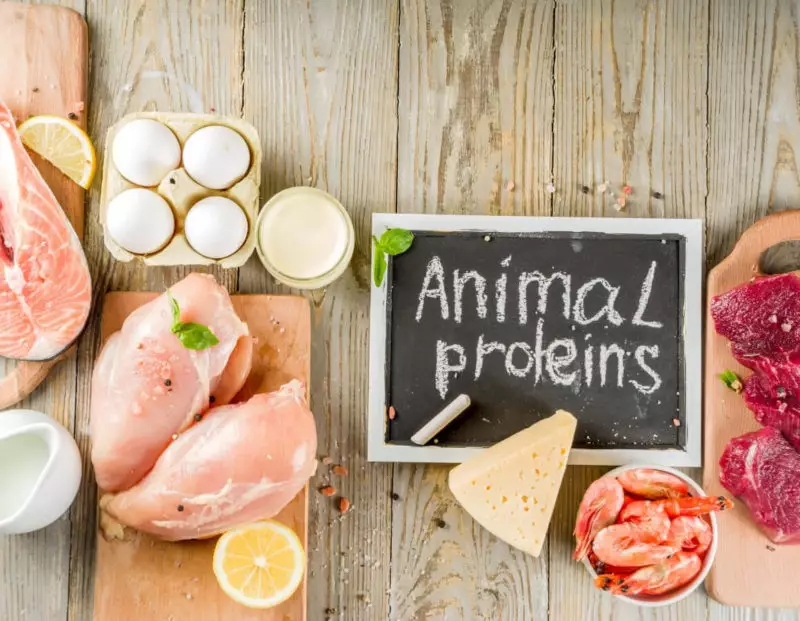
Protein is one of the three dietary macronutrients, along with fats and carbs. It is made of a combination of different amino acids. There are two main types of protein: animal protein and plant-based protein.
Protein from animal products is considered as “complete protein,” as it includes all essential amino acids. Plant proteins are considered “incomplete” as they do not contain all essential amino acids. Only whole soy products (e.g., tempeh and edamame) are complete protein plant sources. Generally, a balanced diet includes both types of protein.
Food sources of animal protein include [1] :
- Lean red meat
- Poultry
- Fish and seafood
- Eggs and dairy products
Foods rich in plant protein are [1]:
- Nuts and seeds
- Legumes and beans
- Soy
- Whole grains
But how much protein to eat per day? How to choose what protein foods to eat? Why does your body need protein, and how much is too much?
The answers to these questions are in this article!
Let’s dive in!

Recommended Daily Intake
The recommended dietary allowance (RDA) for protein for healthy individuals with a sedentary lifestyle is 0.8 grams of protein per 1 kilogram of body weight (that equals 0.36 grams of protein per pound weight). [3]
Here is the recommended protein intake by body mass:
| Weight(kg) | Weight(pound) | Protein (grams) |
|---|---|---|
| 50 kg | 110 lb | 40 g |
| 60 kg | 132 lb | 48 g |
| 70 kg | 155 lb | 56 g |
| 80 kg | 175 lb | 64 g |
| 90 kg | 200 lb | 70 g |
| 100 kg | 220 lb | 76 g |
| 110 kg | 240 lb | 84 g |
| 120 kg | 265 lb | 92 g |
With the current RDA, protein accounts for about 10% of the total consumed daily calories (based on a 2000kcal diet). If the current RDA doubles, protein could account for 20-25% of the total consumed daily calories. And according to the Institute of Medicine, Food and Nutrition Board, adults should get 10 to 35 percent of their energy from protein. [5]
Here is the recommended protein intake by consumed daily calories:
| Daily calories consumed | Calories from Protein |
|---|---|
| 1200 kcal | 180 kcal |
| 1400 kcal | 210 kcal |
| 1600 kcal | 240 kcal |
| 1800 kcal | 270 kcal |
| 2000 kcal | 300 kcal |
| 2200 kcal | 330 kcal |
| 2500 kcal | 375 kcal |
Realistically, the average American eats proteins from both plant and animal sources, which account for about 16% of their total consumed calories. With that in mind, the Protein Summit reports published in the The American Journal of Clinical Nutrition suggest that 16% is, in fact, too little amount of protein per day. [4][6]
Even though protein is an essential macronutrient, you can still eat too much. According to the MayoClinic, excess protein intake is considered intake of more than 2 grams of protein per kilogram body weight (0.9 grams/lb) each day. [13]
That being said, every person should take into account their age, sex, health condition, and activity level when calculating how much protein to eat. The final amount may vary.

People who need more protein
People who have an active lifestyle, want to lose weight, or are older than 45 need to eat more protein than the recommended amounts for the general public.
Weight loss
Recommended protein intake for weight loss is:
| Weight(kg) | Weight(pound) | Protein (grams) |
|---|---|---|
| 50 kg | 110 lb | 100 g |
| 60 kg | 132 lb | 120 g |
| 70 kg | 155 lb | 140 g |
| 80 kg | 175 lb | 160 g |
| 90 kg | 200 lb | 180 g |
| 100 kg | 220 lb | 200 g |
| 110 kg | 240 lb | 220 g |
| 120 kg | 265 lb | 240 g |
The same source suggests that athletes and people who exercise a lot AND want to lose weight should aim to consume between 2.2 and 3.4 grams of protein per kilogram body weight (1-1.5 grams/lb).
Active lifestyle
According to the MayoClinic, athletes and people who exercise regularly need to eat more protein than the general recommendation. The source suggests intake of 1.1-1.5 grams of protein per kilogram body weight (0.68 grams/lb). [8] The recommendation for people who lift weights, train for a marathon, or cycling and running events is between 1.2 and 1.7 grams of protein per kilogram body weight (0.76 grams/lb.)
The recommended protein intake for athletes and people who exercise regularly is:
| Weight(kg) | Weight(pound) | Protein (grams) |
|---|---|---|
| 50 kg | 110 lb | 75 g |
| 60 kg | 132 lb | 90 g |
| 70 kg | 155 lb | 105 g |
| 80 kg | 175 lb | 120 g |
| 90 kg | 200 lb | 135 g |
| 100 kg | 220 lb | 150 g |
| 110 kg | 240 lb | 165 g |
| 120 kg | 265 lb | 180 g |
Age
Generally, people start losing muscle mass once they reach 40-50 years of age. Actually, muscle begins to atrophy if a person is not weight training from age of 30. To prevent muscle loss and sustain their wellbeing, such individuals are recommended to increase their protein intake from 0.8 to about 1 gram/kilogram body weight (0.45grams/lb). [8]
Recommended protein intake for people over 40:
| Weight(kg) | Weight(pound) | Protein (grams) |
|---|---|---|
| 50 kg | 110 lb | 50 g |
| 60 kg | 132 lb | 60 g |
| 70 kg | 155 lb | 70 g |
| 80 kg | 175 lb | 80 g |
| 90 kg | 200 lb | 90 g |
| 100 kg | 220 lb | 100 g |
| 110 kg | 240 lb | 110 g |
| 120 kg | 265 lb | 120 g |

Benefit from integrated and personalized approach to nutrition, health, fitness and healing. Check out the schedule for booking online yoga and barre classes (Virtual classes, private sessions, recordings available), or book a nutrition consultation on Annetteoneillwellness.com!
People who need less protein
People who are diagnosed with liver or kidney issues should consume less protein than the generally recommended amount.
Evidence suggests that limiting protein intake to 0.55-0.6 grams per kilogram body weight (0.26 grams/lb) may slow down the decline in kidney functions and need for dialysis. [10]
The recommended protein intake for individuals diagnosed with kidney disease:
| Weight(kg) | Weight(pound) | Protein (grams) |
|---|---|---|
| 50 kg | 110 lb | 28 g |
| 60 kg | 132 lb | 33 g |
| 70 kg | 155 lb | 39 g |
| 80 kg | 175 lb | 44 g |
| 90 kg | 200 lb | 50 g |
| 100 kg | 220 lb | 55 g |
| 110 kg | 240 lb | 61 g |
| 120 kg | 265 lb | 66 g |
For patients with kidney failure, mid-to-late stages of chronic kidney disease (CKD), and kidney patients on dialysis: It is essential to speak with their healthcare provider or registered dietitian and get personal recommendations on their target daily protein intake.
Why is it healthy
Protein is essential to human health, as it is responsible for the growth and repair of tissues. Protein consumption directly affects the hair, skin, and muscles. [11] Not eating enough protein (and lacking protein diversity) daily may result in stunting, anemia, muscle weakness, edema, vascular dysfunction, and weak immune system. [12]

How to choose a healthy protein
Eating more protein doesn’t necessarily mean eating more meat! This is a common mistake that most people who increase their protein consumption make. Even though animal protein is higher quality protein, including plant protein sources is essential.
Evidence suggests that high consumption of processed red meat and eggs is associated with a higher risk of all-cause mortality, while high intake of unprocessed red meat, eggs (eggs are ok in moderation), and dairy foods may increase the risk of heart disease mortality. The study concludes that substituting animal protein with plant protein may decrease the risk of all-cause, heart disease, and dementia mortality. [15]
Protein powder supplements are a popular choice among people who aim to increase their protein intake. Read labels carefully to avoid protein powders that contain too much added sugar and are high in calories, and to avoid BPA. research by the non-profit organization Clean Label Project found that many protein powder supplements contain BPA (compound used for plastic production, considered to be an endocrine disruptor), pesticides, heavy metals (like lead, arsenic, cadmium, and mercury), and other potentially toxic contaminants. [17]
Incorporating whey protein powder or vegan pea, brown rice and other plant based powders are a good way to ensure adequate protein.
All in all, supplying enough protein from a balanced and diverse diet is the best way to go!








